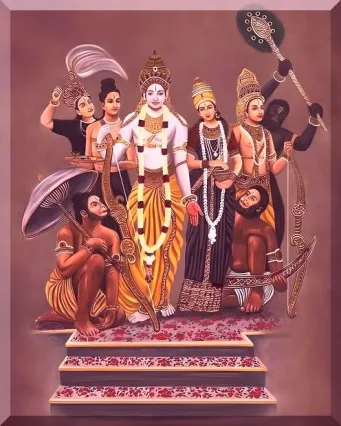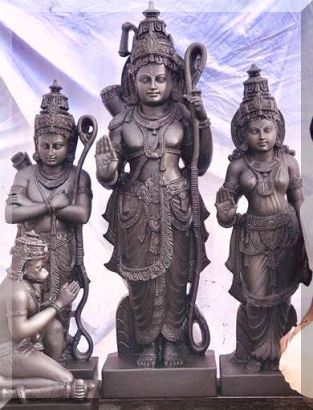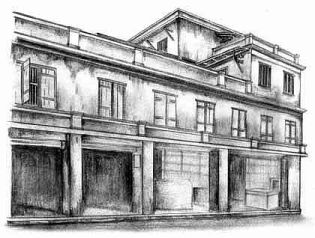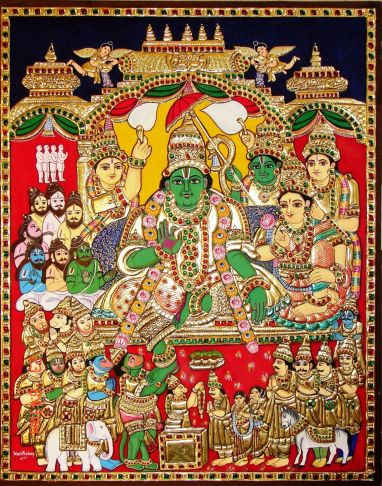(For my friend Shri Kannan Rangachar)
Continued from Part IV
40.1. Sri Tyagaraja was born in Thiruvarur, a small town in Tanjavuru District. While he was still a very young boy, his family moved into a house on the Tirumanjana Street, at Thiruvaiyaru (about 50 KMs away) that was gifted by the King of Tanjavuru. Sri Tyagaraja lived the rest of his life in that house. Thiruvaiyaru is just about 13 KMs from Tanjavuru. He moved about, all his life, in the Thiruvaiyaru-Tanjavuru region. He did not travel outside of that limited area until he was about seventy-two years of age. How his first and the only travel outside that region came about is rather interesting.
40.2. It is said; that around the year 1839 , one Kovur Sundaresa Mudaliyar a wealthy merchant and a Dubash (interpreter as also one who acted as steward, banker and general agent) of the British East India Company at Madras, called on his Guru Sri Upanishad Brahmendra Sarasvathi at Kanchipuram in order to pay his respects. During the course of the conversation, Sundaresa Mudaliyar mentioned about a saintly person named Tyagaraja, residing at Thiruvaiyaru, who was composing divine songs and singing them beautifully. He suggested that the Swamin, at some time, could listen to his songs.
Thereupon, Sri Upanishad Brahmendra said that he too had heard of Tyagaraja and his music. Then, he went on to say that, in fact, he was well familiar with Ramabrahmam who was his fellow-student and also with his son Tyagaraja while the latter was a young boy of 10 or 12.
40.3. That conversation with Sundaresa Mudaliyar brought back to the Swamin the old memories. And, he longed to see the boy, he once knew, now grown into a musical celebrity. Sri Upanishad Brahmendra, at the instance of Sundaresa Mudaliyar, decided to send an invitation asking Thyagaraja to visit him at Kanchipuram.

41.1. In the past, that is to say, around the year 1780 , Sri Upanishad Brahmendra, then living at Tanjavuru, was known by his Sanyasa-ashrama name Ramacandrendra Sarasvati. There at Tanjavuru, he used to conduct discourses on Ramayana and also lead chorus-singing of the devotional songs he composed in praise of Sri Rama. It is said, the boy Tyagaraja who was in his early teens, say of ten-twelve years, used to attend, along with his father (Ramabrahmam), those musical discourses and Bhajans. (Thiruvaiyaru where the Ramabrahmam family lived is just 13 Km from Tanjavuru).
41.2. The influence of Sri Upanishad Brahman on Tyagaraja was very significant. Sri Rama was the Ista-devata of the Swamin. He inspired in the boy-Tyagaraja the intense fervour of devotion to Sri Rama and the Love for singing the glory of the Lord, nama-samkirtana.
41.3. The musicologists and experts opine that the traces of Ramachandrendra Sarasvati‘s influence can be found in the Divya-nama-samkirtana songs later composed by Sri Thyagaraja. They point out the similarities in the structure of songs and in the word-play (pada-jaala) employed by Sri Thyagaraja and his inspiration, Ramacandrendra Sarasvati.
For instance; it is said; Sri Tyagaraja’s songs : Dhyaname varamaine, Ganga snaname and Koti-nadula which emphasize that the real snana and thirtha (the bath and the holy waters of the pilgrimage) are verily in the contemplation on the name of the Lord and not in the rivers, were inspired by Sri Upanishad Brahmendra‘s Tarangas in his Sri Rama Taranga.
It is also mentioned that this work of Sri Upanishad Brahmendra was in turn influenced by the songs in most enchanting opera Krishna-Leela-Tarangini of Sri Narayana Thirtha (1650 -1745).

42.1. Following the suggestion of Kovur Sundaresa Mudaliyar, Sri Upanishad Brahmendra sent an invitation to Tyagaraja. In his letter (Sri-mukham) , Sri Upanishad Brahmendra mentioned that though he was very desirous of listening to Tyagaraja’s divine music he was unable to visit Thiruvaiyaru as he was in no position to travel long distances because of his ’extreme age’ (viparita ayu) . And, he said, he would appreciate if Tyagaraja could visit him at Kanchipuram and let him have the pleasure of listening to sublime music celebrating the glory of Sri Rama. The letter “Sri-mukham’ (a formal communication bearing the official seal and insignia of the Mutt) was sent to Sri Thyagaraja through Tanjavuru Rama Rao who was acting as a sort of manager and caretaker of Tyagaraja, after the demise of his (Sri Tyagaraja’s) wife Kamalamba.
[It is said; that Sri-mukham along with some of Tyagaraja’s compositions, in his own writing on palm leaf, are preserved in the Saurastra Sabha at Madurai.]
42.2. The invitation from Sri Upanishad Brahmendra threw Sri Thyagaraja into a bit of dilemma. To start with, he was not used to travelling; and, he also did not like any deviations or distractions cutting him away from his daily worships and Samgita-sadhana. And at the same time, he could not refuse the invitation from a very senior person whom he respected and one whom he regarded almost as a guru (guru-samana). In the heart of his heart he was most unwilling to leave his home and his daily worship (Rama-panchayatana) of his beloved deity Sri Rama.
He was restless for a couple of days. It is said, it was during these stressful days that Sri Tyagaraja sang the kriti in Thodi Raga “koti nadula danushkoti lo undaga, etiki tirugadave O manasaa’; meaning when millions of rivers are merged in danushkoti (the ocean) why do you wander aimlessly, Oh my mind. However, after his disciples assured and promised to conduct regularly the daily Puja of his deity Sri Rama, without fail, Sri Thyagaraja agreed to make the trip.
42.3. According to the travel plans drawn up , finalized and arranged by the Manager Tanjavuru Rama Rao, Sri Tyagaraja and party were to first visit Sri Rangam; then on to Kanchipuram to call on the sage Sri Upanishad Brahmendra honouring his invitation ; and from there to Tirupthi-Tirumala to have the darshan of Lord Venkateshwara . The return journey would take the route of: Madras, Tiruvattiyur and Lalgudi. Each of those places is a celebrated centre of pilgrimage.
***
44.1. In the summer of 1839 (April) when Sri Tyagaraja was seventy-two years of age, he departed from Thiruvaiyaru after attending to the seven-day Chaitra-maasa Saptastana Utsavam celebrations at Panchanadeeswara (Shiva) temple. The travel party included about twenty disciples; and during most of the journey Tyagaraja was carried in a palanquin.
44.2. The party reached the temple city of Sri Rangam in May 1839 during the course of the Chaitrothsavam of the Lord Ranganatha. During his halt at Sri Rangam, Sri Tyagaraja composed five songs (Sri Ranga-pancha-ratna) in adoration of Lord Ranganatha: O Ranga shayee (Kambodhi); Chootamu Raaare (Arabhi); Vinaraadha (Deva Gandhari); Raju Vedale (Thodi) ; and, Karuna joodu Malayya ( Saranga).
44.3. After worshipping Lord Sri Raganatha at Sri Rangam, the party reached Kanchipuram when the Dolothsavam of the Lord Varadaraja Swami was in progress. Sri Thyagaraja was delighted; and in ecstasy he burst forth into the song Varadaraja Ninnukori vacchiti’ (Swarabooshani). While at Kanchipuram, he also sang Varada Navanita (ragapanjaramu).
45.1. Then, Sri Tyagaraja called upon his Guru-samana Mentor Sri Upanishad Brahmendra after long-long years. When they first met (c. 1780) in Tanjavuru, Sri Upanishad Brahmendra, youth of thirty-three was in the prime of life; and his admirer Tyagaraja a lad of twelve was just on the threshold of life. They did not meet again for a very long years. And, when they met at Kanchipuram (1839) after a lapse of about sixty years, both had grown into ripe old sages glowing with mellow joy; Sri Upanishad Brahmendra was in ripe old age at about 92 and Sri Tyagaraja too was at about 72. During those long years both walked the path of life with singular devotion in pursuit of their aspirations and ideals. Both achieved success substantially. The meeting at Kanchipuram was between two blessed and enriched persons sharing mutual regard and admiration.
Sri Upanishad Brahman was greatly delighted by the musical excellence and pure devotion of Sri Tyagaraja. He enjoyed every moment of Tyagaraja’s stay with him. He is said to have remarked it was worth waiting almost a lifetime for enjoying the delight (raga –sudha) of Sri Tyagaraja’s music.
46.1. After a stay of about two weeks at the Sri Upanishad Brahmendra Ashram (during which time they also participated in the Annual Uthsavam of Sri Varadaraja) , the party left for Tirupathi by way of Walajapet where Sri Tyagaraja’s disciple Venkataramana Bhagavatar and his family were waiting anxiously to receive their Guru. There, they took him in a procession to at their Bhajana Mandiram.
It is said ; ” while Sri Tyagaraja was being taken in procession, Venkataramana Bhagavatar’s disciple, Mysore Sadashiva Rao composed the kriti ‘Tyagaraja-swami vedalina’ in Todi Raga; and, ‘sang it in the immediate presence of the great saint and earned his blessings”.
Sri Tyagaraja stayed with Venkataramana Bhagavatar’s family for about 12 days, before proceeding to Tirupathi.
46.2. At Tirupathi, Sri Tyagaraja had the Darshan of Lord Venkateshwara. And there, he is said to have composed the Kritis: Terateeyagarada (Gowlipanthu) and Venkatesaninnu sevimpa (Madhyamavathi). He is said to have stayed at Tirupathi for about five days.
46.3. On the way back from Tirupathi , Sri Tyagaraja is said to have made a brief halt at Sholingur where he composed a song praising Hanuman for his immense power of making the impossible possible : Paahi Rama dhootha jagath prana kumara ( Vasantha –varali ).
46.4. At the request of his disciple Veena Kuppayyar, Sri Tyagaraja and party visited Madras where they stayed at 41, Bunder Street, George Town, the palatial residence of Kovur Sundaresa Mudaliyar the Dubash.

A drawing of Kovur Sundaresa Mudaliar’s House (as it might have then existed) at 41, Bunder Street, George Town – thanks to Sri V Sriram
There followed a most memorable week of rich music , the highlight of which was Sri Tyagaraja’s elaborate rendering of a Pallavi in Deva-gandhari Raga.
In June 1839, during his stay at Madras, Sri Tyagaraja visited Sundaresa Mudaliyar’s native village Kovur situated nearby. There at the Sri Sundareshwara temple, at the time of its vaisakha visakam festival, Sri Tyagaraja composed and sang five Kritis in praise of the Lord. The set of these five Kritis has gained fame as Kovur Sundareswara Pancha-rathna Kriti: Shambo Mahadeva (Panthurvarali); Sundareswaruni (Sankarabharanam); Nammi Vachina (Kalyani); Eee vasudha neevanti (Sahana); and Kori sevimparare (Kharaharapriya).
Again, as requested by his disciple Veena Kuppayyar, Sri Tyagaraja visited his home in Thiruvottiyur, a nearby village, where he composed and sang another set of five songs on the presiding deity of the temple there , Devi Tripurasundari: Kanna-thalli (Saveri); Sundari naninnu (Arabhi); Sundarinee divya roopamu (Kalyani); Sundari nannindarilo (Begada) and Dharini thelusu konti (Sudha Saveri). It is also said; here, Sri Tyagaraja sang a song in praise of Sri Venugopalaswami , the family deity of Kuppayyar.
46.5. On his way back from Madras at Nagapattinam, Sri Tyagaraja sang two songs: Karmame Balvanthamayenu (Saveri) and Evaru theliya boyyeru (Thodi).
46.6. On the way from Nagapattinam to Tanjavuru, Lalgudi Rama Iyer, a disciple of Sri Tyagaraja requested him to visit the temple of Shiva as Saptha-rishieeswara and of his consort Devi Srimathi at his village Lalgudi (otherwise known as Tapas Tirthapura). Here again , he composed and sang a set of five Kritis – two on Saptha-risheeswara and three on Srimathi – Isha pahimam (Kalyani); Deva Sri Thapas-theertha (Madhyamavati) , both on Sri Saptha-reeshswara; Lalithe Sri pravriddhe (Bharivai); Gathi neevani (Thodi); and Mahitha Pravriddha (Kambhoji), all three on Sri Devi.
Interestingly, it is only the Lalgudi-Pancha-rathna Kritis that include songs on the Lord as also on the Devi. In his all other sets of Kritis it is either the Lord or the Devi that is celebrated.
47.1. And after reaching home at Thiruvaiyaru, in October 1839, Sri Tyagaraja prayed at the temple of Lord Panchanatha and Devi Dharmasamvardhani.
[Sri Tyagaraja, in all, has sung twelve songs in praise of Panchanatheeswa (4) and Devi Dharmasamvardhini (8). The Kritis in praise of the Lord are: Ilalo Pranatharthi-harudu (Adana); Evarunnaru Brova (Malavasri); Eki Thrijagadeesa (Saranga); and, Muchada Bramhathulagu (Madhyamavathi).
The eight Kritis in praise of Devi are: Karuna chupavamma (Thodi); Parasakthi Manubaratha (Saveri); Neevu brovavela, Paale Paalendhu (Reethi-Gaula); Amma Dharmasamvardhini (Adana); Vithi Sakrathulagu (Yamuna Kalyani); Shive Pahimam (Kalyani); and , Amma Ninnu Nammithini (Aarabi).]
***
48.1. Sri Tyagaraja’s tour lasted for about six months or a little more (from April to October 1839). This was the only elaborate tour that Sri Tyagaraja ever took in all his life; and, Tirupathi was the farthest place in North that he visited. The trip which, basically , was undertaken to honour the invitation extended by his guru-samana Sri Upanishad Brahmendra turned out a great success; and musically highly rewarding and productive. It was a blessing and a boon to Karnataka – music. It gave birth to series of compositions, kriti-groups popularly called kshetra-kritis of great merit. They are musical gems; remarkable for their soulful music, inspired rich lyrics and complex structure. The music lovers are in eternal debt to Sri Upanishad Brahmendra and the creator of sublime music Sri Tyagaraja.
***
[Kshetra kirtanas
49.1. At each of the places and the temples he visited, Sri Tyagaraja composed inspiring kritis singing the glory of its presiding deities: Varadaraja (Sri Rangam); Kamakshi (Kanchipuram); Venkateshwara (Tirupathi); Kovur (Sundareshwara); Lalgudi (Saptharisheeswar and Srimathi). For details: please check Kshetra-Kirtanas.
It was a tradition in those days for the musical composers of merit to compose and sing songs in honor of the presiding deities whenever they visited a prominent temple-town. Such compositions were classified as Kshetra kirtanas. Sri Tyagaraja followed that good tradition sampradaya , the time honoured practice. Sri Muthuswami Dikshitar too followed this practice. He, in addition, built into his kritis brief references to the temple, its architecture, its rituals and its deity. Amidst these details he skilfully wove the name of the raga (raga mudra) and his own Mudra, signature. All these were structured into well-knit short kritis of grand music glowing with tranquil joy.]

Sources and References
Manaku Teliyana Tyagaraju: http://eemaata.com/em/issues/200809/1337.html
Tyāgarāja and the Renewal of Tradition: Translations and Reflections by William Joseph Jackson
http://en.wikipedia.org/wiki/List_of_compositions_by_Tyagaraja
The Musical Works of Thyagaraja by Prabhakar Chitrapu Prabhakar
http://www.sruti.org/sruti/srutiArticleDetails.asp?ArticleId=4
Kshetra kirtana by P. Sreenivasan
http://www.ipnatlanta.net/camaga/vidyarthi/MusicPhilosophy/KshethraKritis.htm



Rsr Swamy
September 20, 2019 at 9:15 am
Respected Sir, Read through all the five parts of your blog on Thyagaraja. Great writing. Thank you. A few requests.
1) You are a prolific blogger and each blog post has quite long passages. Inevitably, many precious posts get buried in the ‘stack’. For this reason, I prefer, a website, which gives ‘direct access’ to the ‘pages’. It may be possible to have such pages in blogs also but I am told that search engines do not ‘see’, ‘pages in blogs’.
Sometimes, it may be difficult even for the writer to quickly find a particular page. despite the search by tag facility.
Do i have your permission to create a page giving links and a brief description of each blog post , for more easily sharing ?
Kindly have a look at the page that I did just now for my reference.
I have to add a synopsis for each blog post of yours.
Reading itself , just a cursory reading at that, takes a few hours!
How do you find time for such diligent creations?
—————
2) I request you to give standard transliteration of sanskrit and telugu /kannada words.
Best Regards.
RSR.
sreenivasaraos
September 29, 2019 at 2:24 am
Dear Shri Swamy
Thank you for reading the articles closely. I appreciate your intent and efforts to bring these closer to other readers. And, I am grateful to you for the interest you are evincing.
As regards reaching an individual article forming a part of a broad subject; I presume it is neither very complicated, nor is it tough. An interested reader may refer to the subjects of her/his choice listed under the head Categories, on each page, appearing on her/his right-hand-side. A click on the selected subjects will lead to the articles posted there under.
For instance; Tyagaraja (5); Muthuswami Dikshitar (8); Sangita (23); Samkhya (6); Varuna (7) etc., will reveal all the installments or parts the main article.
I trust that might help.
And, BTW, the Google and other search engines have been picking up the specific terms , subjects etc., related to these articles.
Thank you again for your kindness and help
Regards
Gaanakala Kasthuri Vidushi Rupa Sridhar
November 29, 2020 at 8:51 am
It is a very enriching experience to read your well researched articles. Thank you. Keep writing.
Gaana Kasthuri Vidushi Rupa Sridhar.
sreenivasaraos
November 29, 2020 at 2:22 pm
Respected Madam
I am very happy you read the series of articles on Sri Thyagaraja
The appreciation coming from an erudite scholar , a reputed Musician and Guru is truly valuable
*
Please also go through the following series of articles I posted ; and , let me know
I am keen to learn of your views there on
Sri Mutthuswamy Dikshitar
Sri Shyama Shastry
Music of India ( a fairly lengthy series)
*
Thank you Madam
Regards
Gaanakala Kasthuri Vidushi Rupa Sridhar
November 29, 2020 at 8:52 am
It is a very enriching experience to read your well researched articles. Thank you. Keep writing.
Gaanakala Kasthuri Vidushi Rupa Sridhar.
sreenivasaraos
November 29, 2020 at 2:27 pm
Respected Madam
I am very happy you read the series of articles on Sri Thyagaraja
The appreciation coming from an erudite scholar , a reputed Musician and Guru is truly valuable
*
Please also go through the following series of articles I posted ; and , let me know
I am keen to learn of your views there on
Sri Mutthuswamy Dikshitar
Sri Shyama Shastry
Music of India ( a fairly lengthy series)
*
Thank you Madam
Regards